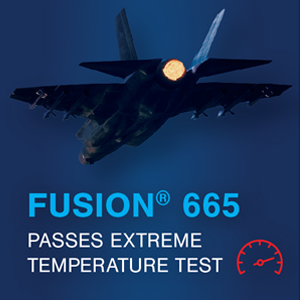Chill Out! This Seal Material Passes Extreme Temperature Test with Flying Colors

Finding a seal material that can withstand the high fluid temperatures of aircraft hydraulic systems without compromising the integrity of your seal can be a challenge. Many of the available elastomeric seal materials are known to harden, degrade, and experience increased compression set, ultimately resulting in leakage and seal failure, especially at subsequent low temperatures. This makes it difficult to pass the requirements of modern aircraft that are addressed in SAE Aerospace Specifications (AS) and Aerospace Material Specifications (AMS), such as the long-standing military hydraulic specification AS5440, or in newer material specifications like AMS7379.
Weighing the Pros and Cons
To choose the best sealing material for your hydraulic system application, you might want to understand the range of materials available and how temperature impacts their performance. Here are three materials to consider:
Nitrile Rubber (NBR) materials have excellent low temperature capabilities and show good abrasion resistance, but the traditional nitrile tends to age, harden and experience compression set when operated over +240°F (+116°C), leading to low temperature leakage. This includes materials meeting AMS-P-83461 and MIL-P-25732 specifications.
Fluorosilicone (FVMQ) materials, such as AMS-R-25988, can typically achieve very low temperatures while maintaining some level of elevated temperature performance (-80°F to +350°F / -62°C to +176°C). However, it does have several drawbacks that often prevent its use as a viable replacement for NBR and FKM, especially in demanding military applications, including poor dynamic performance with low tear strength and abrasion resistance, lower sealing force and a higher compression set allowable.
Fluorocarbon Elastomers (FKM) have excellent upper temperature performance and chemical compatibility. Unfortunately, traditional FKM materials can show poor leakage control at temperatures below -40°F (-40°C), such as those meeting AMS7276 and AMS7287. The newer AMS7379 specification brings FKM minimum temperature capabilities down to -60°F (-51°C), but that still falls short of the standard -65°F (-54°C) requirements.

Why a New FKM AMS SPEC
Due to the limitations of existing elastomer materials, there was a need to develop a new class of FKM that can operate at a lower (-65°F / -54°C), as well as a higher (+400°F / +204°C) temperature, while offering great chemical compatibility and abrasion resistance.
The new AMS7410 specification establishes an FKM material that is a true alternative to NBR suffering from heat aging where subsequent low temperature performance is critical down to -65°F (-54°C).
Fusion® FKM 665 meets and exceeds AMS7379, as well as the new AMS7410. Its broad temperature range (-70°F to 450°F / -57°C to 232°C) allows it to perform well at low temperatures with excellent leakage control. It has extremely low compression set, broad chemical compatibility, and good abrasion resistance, besting existing NBR, FKM and FVMQ solutions. This material has been thoroughly tested and proven to perform at -65°F (-54°C) and lower.
Fusion® FKM 665 (AMS7410) can enable the next generation of performance in new military aircraft programs and can elevate the capabilities of existing programs.
YOU MAY ALSO LIKE